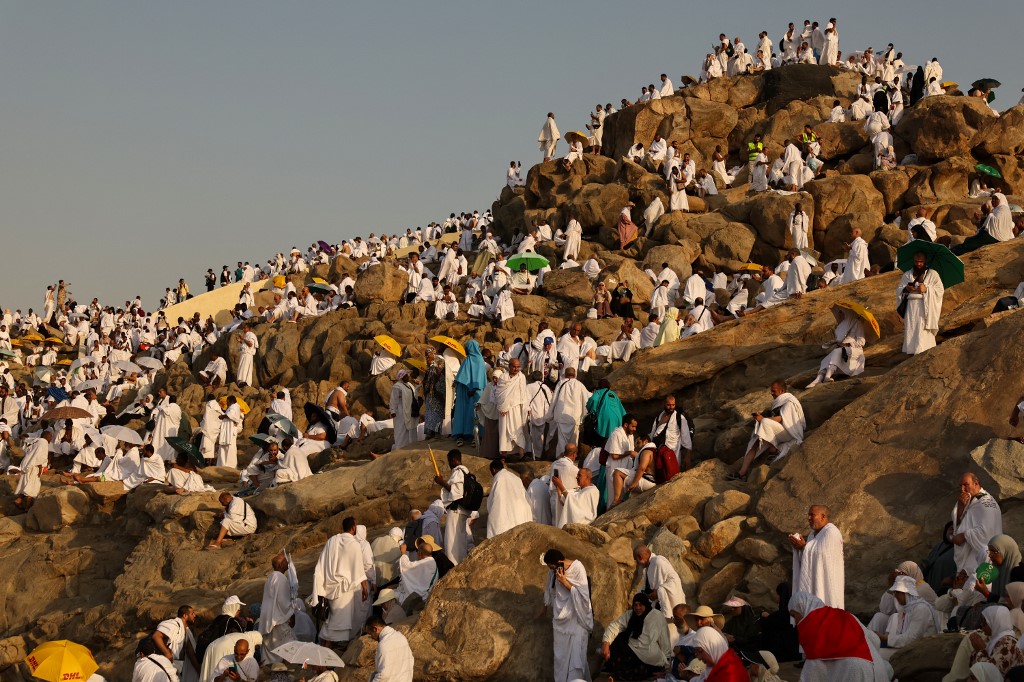Muslim Pilgrims Gather on Mount Arafat for Hajj Climax
More than 1.5 million Muslims braved scorching temperatures to reach Mount Arafat on Saturday for the culmination of the annual hajj pilgrimage, where they prayed for hours, particularly for Palestinians in war-ravaged Gaza.
Worshippers dressed in white began arriving at daybreak for the most strenuous day of the annual rituals, hiking the rocky, 70-meter (230-foot) peak where the Prophet Mohammed is said to have delivered his last sermon.
“This is the most important day,” said 46-year-old Egyptian Mohammed Asser, who had prepared a litany of prayers. “I also pray for Palestinians.” “May God help them.”
This year’s hajj takes place under the shadow of Israel’s conflict in Gaza with Hamas, which was sparked by the Palestinian terrorists’ unprecedented attack on southern Israel on October 7.
According to an AFP calculation based on Israeli official estimates, the assault killed 1,194 individuals, the majority of whom were civilians.
According to the health ministry of Hamas-ruled Gaza, Israel’s retaliatory military attack has killed at least 37,266 Palestinians, the majority of whom were civilians.
Tawfiq al-Rabiah, Saudi Arabia’s minister in charge of religious pilgrimages, stated last week that “no political activity” will be tolerated during the hajj.
However, at least one pilgrim continued to sing in favor of the Palestinians, who had been bombarded for more than eight months.
Pray for our brothers in Palestine and Gaza. “May God grant victory to the Muslims,” he exclaimed.
Iranian supreme leader Ayatollah Ali Khamenei addressed hajj pilgrims on Saturday, stating that “the ironclad resistance of Palestine and the patient, oppressed people of Gaza…must be fully supported in every way”.
Official media said that approximately 2,000 Palestinians are performing the hajj at the personal invitation of Saudi King Salman.
Scary heat.
According to a Saudi study published last month, climate change is rapidly affecting the hajj, one of the world’s largest religious gatherings, with area temperatures climbing 0.4 degrees Celsius each decade.
The rites, which take at least five days to complete and are primarily performed outside, are “not easy because it is very hot,” according to Abraman Hawa, 26, of Ghana.
“We have sun. But it’s not as hot. “But I’ll pray to Allah at Arafat because I need his help,” she said.
The temperature was forecast to reach 43 degrees Celsius (109.4 degrees Fahrenheit) on Saturday, posing obstacles for pilgrims who arrived at Mount Arafat after spending the night in a massive tented city in Mina, a valley outside Mecca, Islam’s holiest site.
Saudi authorities have advised pilgrims to drink plenty of water and protect themselves from the sun. Men are barred from wearing hats, so many carry umbrellas.
More than 10,000 heat-related ailments were documented last year, with 10% of them being heat stroke, a Saudi official told AFP this week.
Ahmad Karim Abdelsalam, a 33-year-old Indian pilgrim, agreed that the prospect of spending hours on Mount Arafat was “a little scary”.
But, “God willing, everything will go well” with the help of an umbrella and water sprays, he remarked.
Once in a lifetime.
The hajj is one of Islam’s five pillars, and all Muslims who have the means should complete it at least once.
However, visas, which are allocated to particular countries on a quota basis, can be difficult to get.
“It’s a once-in-a-lifetime opportunity, and I couldn’t miss it,” said Abdulrahman Siyam, a 55-year-old Iraqi pilgrim conducting the ceremonies on a prosthetic limb.
Following Mount Arafat, pilgrims will travel to Muzdalifah to collect pebbles for the symbolic “stoning of the devil” ritual in Mina on Sunday.
The hajj is claimed to follow the course of the Prophet Mohammed’s final pilgrimage, which occurred around 1,400 years ago.
It is a significant source of legitimacy for the Al Saud dynasty, whose king holds the title “Custodian of the Two Holy Mosques” at Mecca and Medina.
It is also a significant financial boon for the conservative country, which is attempting to promote religious tourism as part of a strategy to reduce its reliance on crude oil.
Last year, the kingdom had more than 1.8 million pilgrims for the hajj, with almost 90% of them coming from outside.
It also welcomed 13.5 million Muslims who came to undertake umrah, a year-round pilgrimage, with the goal of reaching 30 million pilgrims overall by 2030.



